
Wahbi Al-Hariri
Encyclopedia
Mohamed Wahbi Al-Hariri Rifai , OAL
, (1914–1994) was an Arab-American artist, architect, and author.
, Syria
. He also lived in France, Italy, Lebanon
, Saudi Arabia
, and the United States of America.
the 11th Century poet and philosopher, author of the Maqamat al-Hariri (The Assemblies of al-Hariri) named after him, Ali Al-Hariri-Rifai, the 13th Century theologian, Mustapha Al-Hariri-Rifai the 18th Century musician and theologian, and Abdelrahman Al-Hariri-Rifai the 19th century calligrapher and astronomer
.
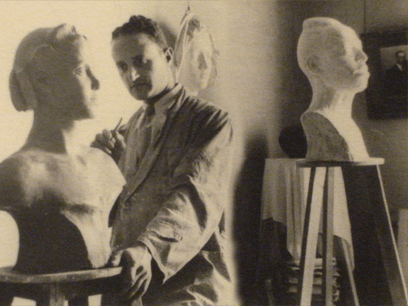 Upon his return to Syria, his artistic work evolved to include sculptures, oil paintings, and photography. He also became actively engaged in archeology and was instrumental in the early efforts to preserve the historic ruins of the city of Palmyra
Upon his return to Syria, his artistic work evolved to include sculptures, oil paintings, and photography. He also became actively engaged in archeology and was instrumental in the early efforts to preserve the historic ruins of the city of Palmyra
. His studio was located in the heart of Aleppo’s old city, medinah, where it occupied several grand rooms on the second floor of an ancient home near the Citadel, al-qual’ah. During that time, his studio became an artistic and social rallying center, a much-sought after social salon and a cauldron of opposition to France’s colonial presence in the Middle East. Wahbi Al-Hariri was widely known for his outspoken and defiant attitude toward the French occupation, and in pointed retaliation the French colonial forces burned his studio just before an art exhibition. As a result, most of his work from this period was destroyed, and only a small collection of his early large oil paintings, portraits, and sculptures survived.
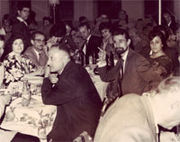 During this time in Syria Wahbi Al-Hariri taught at Aleppo's elite Tajhiz college where he mentored and inspired a generation of Syrian artists including Fateh Moudarres
During this time in Syria Wahbi Al-Hariri taught at Aleppo's elite Tajhiz college where he mentored and inspired a generation of Syrian artists including Fateh Moudarres
, Louay Kayali, Taleb Yazgi, and Mohammed Fathi Kabawah.
, his talent won him a scholarship to Yale University
, but his artistic drive took him to Paris instead to study art and architecture at the École nationale supérieure des Beaux-Arts
(ENSB-A) and historic preservation at the Louvre
.
In 1954, Wahbi Al-Hariri received his D.P.L.G. with honors and was awarded the highly coveted Beaux-Arts Bronze Medal of Distinction.
After returning from France to Syria he immersed himself in his artistic work, wrote extensively, taught, and won several architectural competitions. However, his hopes became frustrated by the growing sense of national unease and the political instability that was rocking the country.
In 1965, a military coup caused the cancellation of a large exhibit of his work and the arrest of some of his acquaintances.
 After a friend’s invitation to visit Saudi Arabia
After a friend’s invitation to visit Saudi Arabia
, Wahbi Al-Hariri grew enamored with the Arabian peninsula
's still pristine vistas and was inspired by the many facets of its little-known heritage. Consequently in 1965 he decided to move to the Kingdom.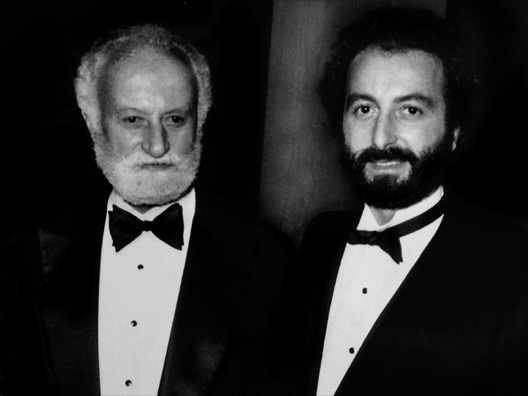 In 1981, after an intensive period of research, travel, and on-site work in some of the Kingdom’s most remote areas, he completed an important collection of large graphite drawings illustrating Arabia’s significant architectural heritage.
In 1981, after an intensive period of research, travel, and on-site work in some of the Kingdom’s most remote areas, he completed an important collection of large graphite drawings illustrating Arabia’s significant architectural heritage.
Subsequently, a full-size facsimile edition of this collection, entitled Traditional Architecture in the Kingdom of Saudi Arabia, was published in Florence, Italy, with the assistance of his son, Mokhless Al-Hariri.
Copies of the book can be found in Queen Elizabeth II's Royal Library
at Buckingham Palace
, the library of Emperor Akihito of Japan, at The Library of Congress in Washington, D.C., and at the Bibliothèque nationale de France
in Paris, as well as several other national libraries worldwide.
The publication of this hand-printed art collector's folio brought about worldwide recognition of his classical artistic work and culminated with a 1984 one-man exhibit of the collection at the Smithsonian Institution
in Washington, D.C. With it, he became the first living artist to be honored with a one-man show of his work at the Smithsonian. The exhibit subsequently went on a tour of several other American museums.
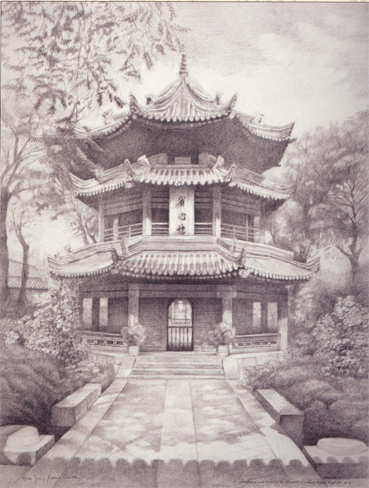 During the last ten years of his life, his spiritual drive and classical artistic talent, coupled with the extraordinary participation of his wife, Widad Marachi—and the earnest encouragements of numerous friends, scholars, and dignitaries throughout the world—inspired him to travel from Spain to China to identify and document the most significant historic mosques of the world.
During the last ten years of his life, his spiritual drive and classical artistic talent, coupled with the extraordinary participation of his wife, Widad Marachi—and the earnest encouragements of numerous friends, scholars, and dignitaries throughout the world—inspired him to travel from Spain to China to identify and document the most significant historic mosques of the world.
Despite a four-year battle with cancer, he was able to produce in record time a body of work that features over forty historic mosques. The collection known as The Spiritual Edifices of Islam , was completed with the assistance of his son Mokhless Al-Hariri, and embodies the final evolution of his distinctive classical yet contemporary style.
Following his death at the age of 80, a large number of his early oil paintings, watercolors, and photographs—some dating back to 1933—were found after having been saved from his initial studio fire. Several pieces underwent extensive restorations and some became part of a travelling retrospective exhibit.
, and Sotheby's
. As recently as in 2009, an unsigned edition of his limited-run folio collection of prints hand-pressed in Florence, Italy by Fratelli Alinari-Institutio di Edizione Artistiche was auctioned.
The majority of his work is held by the family. His works can also be found in several private or national collections and are rarely exchanged or offered on the public market.
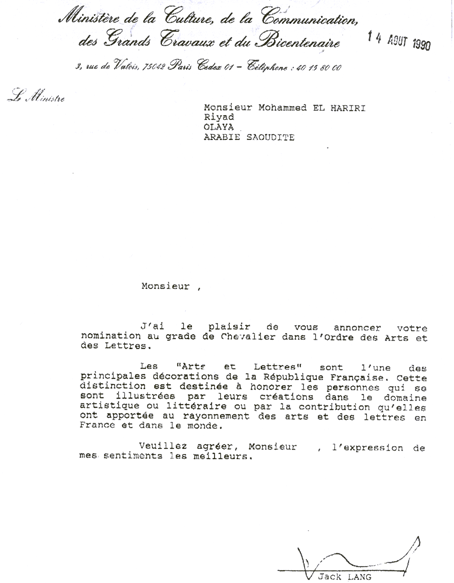
of the French Ordre des Arts et des Lettres
; (Knight, Order of Arts and Letters).
The Royal Swedish Consulate in Aleppo, Syria is located on a street named after the artist.
in Washington, D.C.
In 2002–2003 it was also shown at other world-class venues including:
At Kuala Lumpur, in response to the public’s interest, the exhibit was extended from one to four months.
Lisa Kaaki, drawing on a previous interview she had conducted writes:
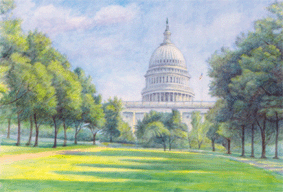
Ordre des Arts et des Lettres
The Ordre des Arts et des Lettres is an Order of France, established on 2 May 1957 by the Minister of Culture, and confirmed as part of the Ordre national du Mérite by President Charles de Gaulle in 1963...
, (1914–1994) was an Arab-American artist, architect, and author.
Biography
Wahbi Al-Hariri was born in 1914 in AleppoAleppo
Aleppo is the largest city in Syria and the capital of Aleppo Governorate, the most populous Syrian governorate. With an official population of 2,301,570 , expanding to over 2.5 million in the metropolitan area, it is also one of the largest cities in the Levant...
, Syria
Syria
Syria , officially the Syrian Arab Republic , is a country in Western Asia, bordering Lebanon and the Mediterranean Sea to the West, Turkey to the north, Iraq to the east, Jordan to the south, and Israel to the southwest....
. He also lived in France, Italy, Lebanon
Lebanon
Lebanon , officially the Republic of LebanonRepublic of Lebanon is the most common term used by Lebanese government agencies. The term Lebanese Republic, a literal translation of the official Arabic and French names that is not used in today's world. Arabic is the most common language spoken among...
, Saudi Arabia
Saudi Arabia
The Kingdom of Saudi Arabia , commonly known in British English as Saudi Arabia and in Arabic as as-Sa‘ūdiyyah , is the largest state in Western Asia by land area, constituting the bulk of the Arabian Peninsula, and the second-largest in the Arab World...
, and the United States of America.
Family
Wahbi Al-Hariri's documented family tree spans over fourteen centuries. Some of his ancestors include Muhammad al-Qasim ibn Ali ibn Muhammad ibn Uthman al-Hariri known as Al-Hariri of BasraAl-Hariri of Basra
Muhammad al-Qasim ibn Ali ibn Muhammad ibn Uthman al-Hariri , popularly known as al-Hariri of Basra was an Arab poet, scholar of the Arabic language and a high government official of the Seljuk Empire...
the 11th Century poet and philosopher, author of the Maqamat al-Hariri (The Assemblies of al-Hariri) named after him, Ali Al-Hariri-Rifai, the 13th Century theologian, Mustapha Al-Hariri-Rifai the 18th Century musician and theologian, and Abdelrahman Al-Hariri-Rifai the 19th century calligrapher and astronomer
Astronomer
An astronomer is a scientist who studies celestial bodies such as planets, stars and galaxies.Historically, astronomy was more concerned with the classification and description of phenomena in the sky, while astrophysics attempted to explain these phenomena and the differences between them using...
.
Accademia di Belle Arti, Rome
Wahbi Al-Hariri began drawing and sculpting as a child. Recognizing his talent, his father furthered his exceptional artistic development and encouraged him in 1932 to be one of the first known contemporary Middle Easterner to travel to Italy to formally study art. In 1937, he graduated from the Accademia di Belle Arti and the Istituto di Dante Alighieri in Rome.Early years and the French mandate

Palmyra
Palmyra was an ancient city in Syria. In the age of antiquity, it was an important city of central Syria, located in an oasis 215 km northeast of Damascus and 180 km southwest of the Euphrates at Deir ez-Zor. It had long been a vital caravan city for travellers crossing the Syrian desert...
. His studio was located in the heart of Aleppo’s old city, medinah, where it occupied several grand rooms on the second floor of an ancient home near the Citadel, al-qual’ah. During that time, his studio became an artistic and social rallying center, a much-sought after social salon and a cauldron of opposition to France’s colonial presence in the Middle East. Wahbi Al-Hariri was widely known for his outspoken and defiant attitude toward the French occupation, and in pointed retaliation the French colonial forces burned his studio just before an art exhibition. As a result, most of his work from this period was destroyed, and only a small collection of his early large oil paintings, portraits, and sculptures survived.

Fateh Moudarres
Fateh al-Moudarres was a Syrian painter and one of the leaders of the modern art movement in Syria. Moudarres studied at the Accademia di Belle Arti in Rome, where he was influenced by Surrealism...
, Louay Kayali, Taleb Yazgi, and Mohammed Fathi Kabawah.
École Nationale Supérieure des Beaux-arts
In 1948, two years after Syria’s independence from FranceFrench Mandate of Syria
Officially the French Mandate for Syria and the Lebanon was a League of Nations mandate founded after the First World War and the partitioning of the Ottoman Empire...
, his talent won him a scholarship to Yale University
Yale University
Yale University is a private, Ivy League university located in New Haven, Connecticut, United States. Founded in 1701 in the Colony of Connecticut, the university is the third-oldest institution of higher education in the United States...
, but his artistic drive took him to Paris instead to study art and architecture at the École nationale supérieure des Beaux-Arts
École Nationale Supérieure des Beaux-Arts
The École Nationale Supérieure des Beaux-arts is the distinguished National School of Fine Arts in Paris, France.The École des Beaux-arts is made up of a vast complex of buildings located at 14 rue Bonaparte, between the quai Malaquais and the rue Bonaparte, in the heart of Saint-Germain-des-Près,...
(ENSB-A) and historic preservation at the Louvre
Louvre
The Musée du Louvre – in English, the Louvre Museum or simply the Louvre – is one of the world's largest museums, the most visited art museum in the world and a historic monument. A central landmark of Paris, it is located on the Right Bank of the Seine in the 1st arrondissement...
.
In 1954, Wahbi Al-Hariri received his D.P.L.G. with honors and was awarded the highly coveted Beaux-Arts Bronze Medal of Distinction.
After returning from France to Syria he immersed himself in his artistic work, wrote extensively, taught, and won several architectural competitions. However, his hopes became frustrated by the growing sense of national unease and the political instability that was rocking the country.
In 1965, a military coup caused the cancellation of a large exhibit of his work and the arrest of some of his acquaintances.
Saudi Arabia

Saudi Arabia
The Kingdom of Saudi Arabia , commonly known in British English as Saudi Arabia and in Arabic as as-Sa‘ūdiyyah , is the largest state in Western Asia by land area, constituting the bulk of the Arabian Peninsula, and the second-largest in the Arab World...
, Wahbi Al-Hariri grew enamored with the Arabian peninsula
Arabian Peninsula
The Arabian Peninsula is a land mass situated north-east of Africa. Also known as Arabia or the Arabian subcontinent, it is the world's largest peninsula and covers 3,237,500 km2...
's still pristine vistas and was inspired by the many facets of its little-known heritage. Consequently in 1965 he decided to move to the Kingdom.

Subsequently, a full-size facsimile edition of this collection, entitled Traditional Architecture in the Kingdom of Saudi Arabia, was published in Florence, Italy, with the assistance of his son, Mokhless Al-Hariri.
Copies of the book can be found in Queen Elizabeth II's Royal Library
Royal Library
Royal Library can mean:*Royal Library, Windsor - the royal library of the Sovereign of the United Kingdom*Danish Royal Library - the national library of Denmark*Dutch Royal Library - the national library of The Netherlands...
at Buckingham Palace
Buckingham Palace
Buckingham Palace, in London, is the principal residence and office of the British monarch. Located in the City of Westminster, the palace is a setting for state occasions and royal hospitality...
, the library of Emperor Akihito of Japan, at The Library of Congress in Washington, D.C., and at the Bibliothèque nationale de France
Bibliothèque nationale de France
The is the National Library of France, located in Paris. It is intended to be the repository of all that is published in France. The current president of the library is Bruno Racine.-History:...
in Paris, as well as several other national libraries worldwide.
The publication of this hand-printed art collector's folio brought about worldwide recognition of his classical artistic work and culminated with a 1984 one-man exhibit of the collection at the Smithsonian Institution
Smithsonian Institution
The Smithsonian Institution is an educational and research institute and associated museum complex, administered and funded by the government of the United States and by funds from its endowment, contributions, and profits from its retail operations, concessions, licensing activities, and magazines...
in Washington, D.C. With it, he became the first living artist to be honored with a one-man show of his work at the Smithsonian. The exhibit subsequently went on a tour of several other American museums.
From Spain to China

Despite a four-year battle with cancer, he was able to produce in record time a body of work that features over forty historic mosques. The collection known as The Spiritual Edifices of Islam , was completed with the assistance of his son Mokhless Al-Hariri, and embodies the final evolution of his distinctive classical yet contemporary style.
- Lisa Kaaki, in her 2002 article in ArabNews, writes of her meeting with Al-Hariri:
The truth is that the artist could rely on perfect sketches representing not only the exact proportions but also all the architectural details, such as columns and cornices necessary for completing the drawings later.
Death and legacy
Wahbi Al-Hariri died on August 16, 1994, in Aleppo, Syria, the birthplace he had not visited for almost twenty years. Until the end he overtly maintained an optimistic view of his condition and remained driven and inspired by an unyielding thirst for "knowledge and constant search for beauty."Following his death at the age of 80, a large number of his early oil paintings, watercolors, and photographs—some dating back to 1933—were found after having been saved from his initial studio fire. Several pieces underwent extensive restorations and some became part of a travelling retrospective exhibit.
- Janet McMahon's 1994 obituary in The Washington Report reads:
Wahbi Al-Hariri-Rifai, a distinguished artist known as "the last of the classicists," died [...] at the age of 80. He was the first Middle Easterner to study art formally in Italy and the first Muslim Arab to be awarded France's Beaux Arts Medal of Distinction. [...]
- Lisa Kaaki writes:
The battles notwithstanding, his last years were prolific ones as he completed some 100 paintings and drawings in only four years.
Posthumous exchanges
Despite being held in close trust by The Al-Hariri Family, some of his work has occasionally surfaced at auction-houses like Christie'sChristie's
Christie's is an art business and a fine arts auction house.- History :The official company literature states that founder James Christie conducted the first sale in London, England, on 5 December 1766, and the earliest auction catalogue the company retains is from December 1766...
, and Sotheby's
Sotheby's
Sotheby's is the world's fourth oldest auction house in continuous operation.-History:The oldest auction house in operation is the Stockholms Auktionsverk founded in 1674, the second oldest is Göteborgs Auktionsverk founded in 1681 and third oldest being founded in 1731, all Swedish...
. As recently as in 2009, an unsigned edition of his limited-run folio collection of prints hand-pressed in Florence, Italy by Fratelli Alinari-Institutio di Edizione Artistiche was auctioned.
The majority of his work is held by the family. His works can also be found in several private or national collections and are rarely exchanged or offered on the public market.

Recognition
In 1991, in addition to numerous other international citations and honors, France further recognized his artistic achievements by awarding him the highly regarded distinction of ChevalierKnight
A knight was a member of a class of lower nobility in the High Middle Ages.By the Late Middle Ages, the rank had become associated with the ideals of chivalry, a code of conduct for the perfect courtly Christian warrior....
of the French Ordre des Arts et des Lettres
Ordre des Arts et des Lettres
The Ordre des Arts et des Lettres is an Order of France, established on 2 May 1957 by the Minister of Culture, and confirmed as part of the Ordre national du Mérite by President Charles de Gaulle in 1963...
; (Knight, Order of Arts and Letters).
The Royal Swedish Consulate in Aleppo, Syria is located on a street named after the artist.
Quotes
Unless otherwise noted, quotes are taken from Lisa Kaaki's article that appeared in 2002.
I caught a glimpse of sun rays filtering through a window, thus lighting up a portion of this magnificent building. I was racing against the sun, desperately trying to finish my sketch before the light disappeared. I knew I had only an hour and a half before sunset.
"بيوت الله" The Spiritual Edifices of Islam: Traveling Exhibit
Also known in Arabic as Buyut Allah ("بيوت الله"), the exhibit made its 1999 world debut at the Smithsonian InstitutionSmithsonian Institution
The Smithsonian Institution is an educational and research institute and associated museum complex, administered and funded by the government of the United States and by funds from its endowment, contributions, and profits from its retail operations, concessions, licensing activities, and magazines...
in Washington, D.C.
In 2002–2003 it was also shown at other world-class venues including:
- The National Gallery of Fine Arts of Amman, Jordan,
- The National Museum of Riyadh, Saudi Arabia,
- The Beit al-Quran Museum of Manama, Bahrain, and
- The Islamic Arts Museum of Kuala Lumpur, Malaysia
At Kuala Lumpur, in response to the public’s interest, the exhibit was extended from one to four months.
Lisa Kaaki, drawing on a previous interview she had conducted writes:
[...]I interviewed [Al-Hariri] several times on television and radio. He spoke with a most engaging passion about his books: "The Traditional Architecture of Saudi Arabia," "The Heritage of the Kingdom of Saudi Arabia" and "Asir: Heritage and Civilization."
After I finished my books, I felt I had to do another one and I thought that if I were to choose a subject, it had to be mosques, he told me during one of our meetings. As he spoke, his eyes lit up and I sensed that I was about to hear something unique [...].
My [Kaaki] last meeting with him was one month before his death. Each time I looked at my notebook, I remembered the unique journey which took him from Spain to China, looking for the most significant mosques in the world. Many times, I wondered if the book — "Spiritual Edifices of Islam" — would ever be published. I was both relieved and deeply moved when I learned that the drawings of the mosques were part of an exhibition at the National Museum in Riyadh.
Exhibit collections
The Spiritual Edifices of Islam traveling exhibit includes two collections:- The Historic Mosques Collection and
- The Retrospective Collection.
Historic mosques collection
- This group of artwork forms the core of the exhibit and consists of 33 large original graphite drawings, featuring from Spain to China, with great artistic sensitivity, some of the world’s most significant historical mosques. The collection embodies the final evolution of the artist’s distinctive classical style and represents the crowning achievement of his artistic career.

Artist retrospective
- This part of the traveling exhibit includes a collection of 30 original oil, watercolor, and graphite pieces that form a broad retrospective of the artist’s work. The collection spans a sixty-year period (1930s–1990s) and includes a special selection of works that Wahbi Al-Hariri completed in Canada, Egypt, France, Greece, Italy, Lebanon, Saudi Arabia, Syria, the UAE, and the United States.
Trust
The collection is owned by The Al-Hariri Family and is toured and exhibited by GDG Exhibits Trust.Books
- Traditional Architecture of the Kingdom of Saudi Arabia
- Asir Heritage and Civilization
- The Heritage of the Kingdom of Saudi Arabia

